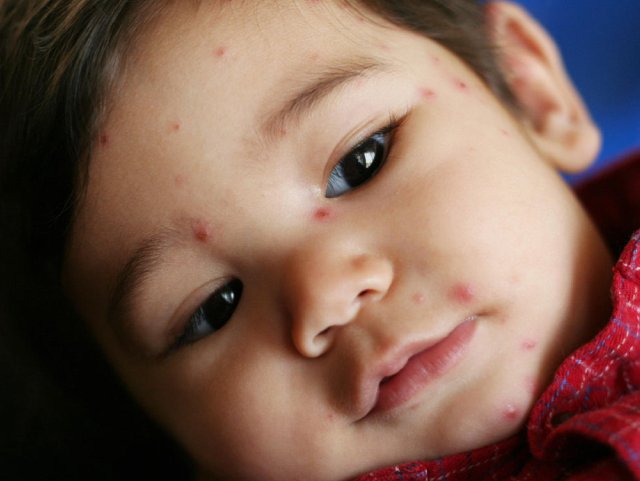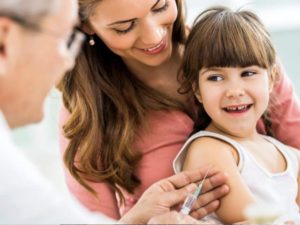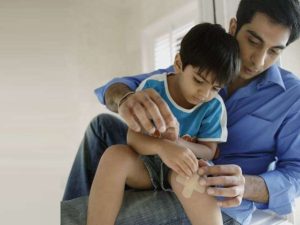Does your heart skip a beat when you spot an angry looking rash on your child’s tender skin? Well breathe easy, as most common childhood rashes are harmless and completely treatable with simple over-the-counter remedies.
Staring from birth, all good mothers make a daily ‘inspection’ of their baby’s skin, often without even realizing it. In an infant, a scaly scalp and diaper rashes are the most bothersome ailments.
Yellow, greasy looking and sticky scales on the scalp of a new born, is a form of dandruff, which often subsides on its own in a few month’s time. Use a gentle shampoo to wash off the scales, and if that doesn’t work, then use a 1% Nizoral shampoo, diluted in equal parts water, once or twice a week, till the scales come off. You can also try gently massaging the scales away using light coconut oil. However, do not leave the oil on the scalp, as that can worsen the scaling. Diaper rash occurs from using non-absorbent diapers, or leaving on a diaper too long, or from not keep the diaper area dry and clean. In some cases, the child might be allergic to the chemical fragrance of a disposable diaper, or the detergent used to wash a cloth diaper. It can get worse, if your child suffers from diarrhea, or if his eating habits have recently changed. The best defense is to change diapers at regular intervals, keep the area clean and dry, and let the skin breathe for a few hours. If your child has already developed a rash, then use the Sebamed diaper rash cream along with plain zinc oxide paste from the pharmacy. Use a slightly larger diaper, and allow your child’s bare bottom to breathe for a few hours everyday. A plastic sheet will protect your flooring and mattress.
Insect bite rashes usually start after the age of 2, and tend to come on and off till the age of 8 or 10, till your child’s body overcomes the allergy. The rashes are not from the bites alone, but from the allergy that is triggered from these bites. Flying insects like mosquitoes, leave bites on the exposed hands and feet. Crawling insects like fleas and bedbugs leave bites on the back and tummy. Use the Johnson&Johnson OFF® cream, which is an insect repellant safe for use in toddlers. Keep your child well covered in full sleeved clothes while playing in the evenings, especially during the summers. If you have a pet at home, make sure your pet is regularly examined by a veterinarian.
Microscopic mites cause an intensely itchy rash called Scabies, which occurs on the fingers, navel, underarms and buttocks. Scabies is contagious, and eventually, every member of the family, and several of your child’s friends will develop a severe itch. If multiple members of the household are suffering from itching, then visit your GP. The entire family may have to use an anti-mite cream like Elimite, and all clothes and bed linen may have to be washed in hot water and detergent.
Head Lice infestations spread quickly. So if you notice lice in your children, inform their school about a possible outbreak. For milder infestations, you can try to get rid of the lice manually, and use lice combs to get rid of nits (lice eggs). I would personally suggest that you use an anti-lice shampoo like RID, not just for the affected child, but for all members of the household. Apply petroleum jelly above eyelashes, if there are nits in the lash area. Get pest control done for your home once a year.
Heat rash, or prickly heat is the appearance of small itchy red bumps on the folds of the skin, or on the back, when your child’s skin overheats in summers. Avoid dressing your child in layers during the summer. Use lotions instead of cream to moisturize your child’s skin in summer, and avoid moisturizer altogether until the rash subsides. Avoid using vaporizing cough rubs on the body; this can worsen the heat rash. A heat rash is a sign that your child’s body is getting too warm, so keep your child in cooler environs, and give plenty of fluids, to avoid a heat stroke. Bathe your child in cool water, adding a spoonful of baking soda to your child’s bath tub. Keep nails short to avoid scratch marks and tears in the skin. A light dusting of cornstarch to dry skin, immediately after the bath, is helpful. Use calamine lotion over the rash, to soothe the irritation.
Does your child have dry, itchy, reddish and sensitive skin? Does your child complain of itching or irritation in winters or with woolen clothing? Does this child also have wheezing? It is possible that your child suffers from Eczema, a non-contagious condition that is part hereditary, and part allergic. Eczema, hay fever (dust/pollen allergies) and Asthma tend to run in families. During infancy, the eczema limits itself to a dry rough rash on the face. As your child starts growing up, you notice a dry scaly itchy rash on the inside of the elbow or the back of the knees. Children who were not exclusively breast-fed for the first six month’s of their life, are more likely to develop Eczema. In my experience, the right skin care regime is all that is needed to keep Eczema at bay. Bathe your child in lukewarm water, only once a day, using a non-soap cleanser like Cetaphil® cleansing lotion. You can add non-perfumed bath oils to the bath water. Seseme oil or Aveeno bath oil is a good choice. Avoid bubble baths. Baths must be quick (within 3-4 minutes), use soft towels to pat (not rub) the skin dry, and bland, non-perfumed moisturizing cream must be applied within minutes of the bath. Paraben free creams like the Sebamed kid’s cream or Exederm baby moisturizer are good buys. Moisturizer must be reapplied more frequently in winters. Avoid denims, silks and synthetic garments. If the rash persists, then insist on meeting a dermatologist, and not a GP. Dry white patches on the face are also due to eczema, which worsens in strong sunlight. Do not use sunscreens in children less than 2 years of age. Deworm your child with Mebendezole tablets once a year. Try the Banana Boat kid’s sunscreen or La Roche Posay Anthelios Pediatrics Spray for older children. Use an aloe-vera gel to soothe sunburns. Always apply sunscreen on your child during sports meet or swimming classes.
Are there skin rashes in children which could be potentially dangerous? If the rash is associated with fever, body ache, red eyes, throat pain, joint pains and/or gland swellings in the neck or pits, then it is usually a sign of a viral fever. The rashes tend to appear all over the body, starting from the face, then spreading downwards. If your child develops a fever, followed by appearance of rash, visit your dermatologist without delay. Keep your child isolated in a separate room, away from his/her siblings. If you’re pregnant, then inform your gynecologist about your child’s rash, and have them speak to your dermatologist as well. Talk to your pediatrician about vaccine options for your other children. Viral rashes usually disappear on their own in a week to ten days. Until then, your child needs bed rest, nutritious food, lots of fluids, Tylenol for fever or pain, and Cetrizine syrup for itching. Apply Calamine lotion on the rashes. DO NOT give Aspirin to children, as it can cause serious brain and liver damage. If you notice chicken pox rashes near the eyes or nose, then consult an Ophthalmologist. Children with Asthma or Diabetes must be monitored closely by a physician during this time.
Lastly, let me add a quick note on ear piercing. I am not in favour of the age-old Asian and Middle Eastern practice of piercing a girl’s ears while she is still a baby! Wait for 6-7 years, let your daughter come to you asking for earrings. That’s when you know she is ready! Get the piercing done by a dermatologist or a registered nurse, using the ear piercing gun, and follow your doc’s instructions to avoid infections. Make sure that your child is fully immunized against Tetanus, as per her age. Use only gold studs for the first month, to avoid allergies.




